Practice Free 300-410 Exam Online Questions
An engineer is configuring a network and needs packets to be forwarded to an interface for any destination address that is not in the routing table.
What should be configured to accomplish this task?
- A . set ip next-hop
- B . set ip default next-hop
- C . set ip next-hop recursive
- D . set ip next-hop verify-availability
B
Explanation:

Refer to the exhibit.
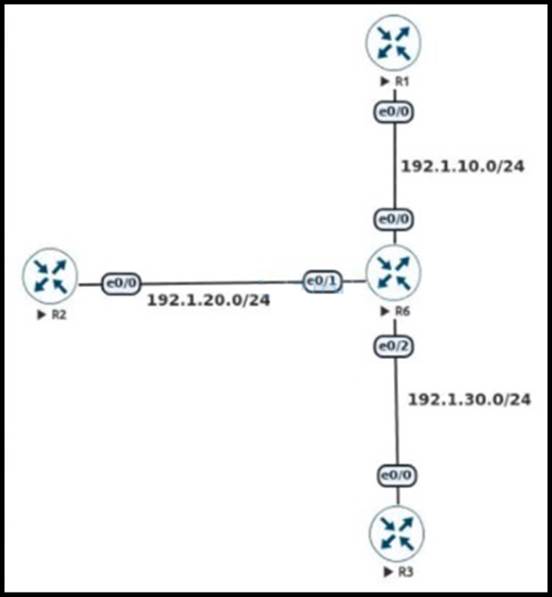
An engineer must configure DMVPN Phase 3 hub-and-spoke topology to enable a spoke-to-spoke tunnel.
Which NHRP configuration meets the requirement on R6?
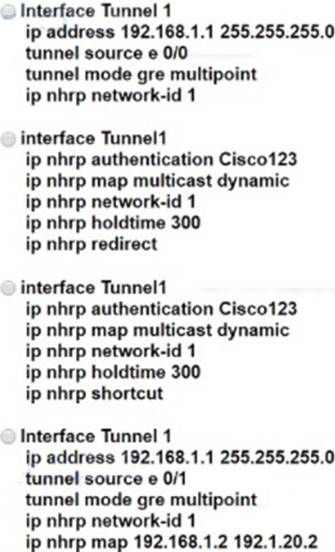
- A . Option A
- B . Option B
- C . Option C
- D . Option D
Refer to the exhibit.
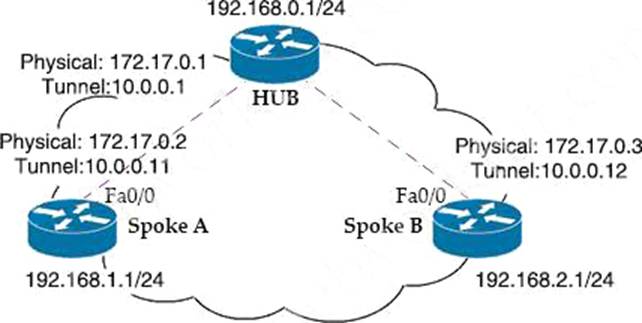
Which interface configuration must be configured on the HUB router to enable MVPN with mGRE mode?
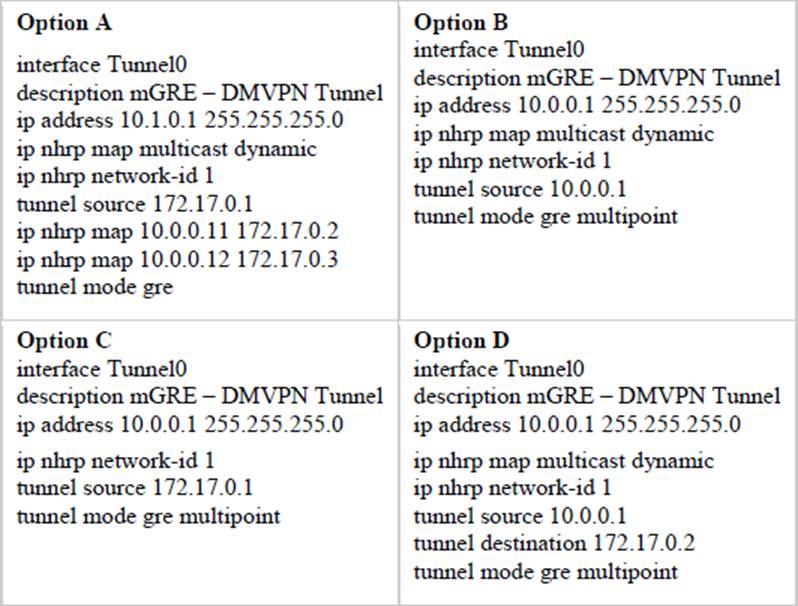
- A . Option A
- B . Option B
- C . Option C
- D . Option D
C
Explanation:
https://www.cisco.com/c/en/us/td/docs/ios-xml/ios/sec_conn_dmvpn/configuration/15-mt/sec-conn-dmvpn-15-mt-book/sec-conn-dmvpn-dmvpn.html
Which method provides failure detection in BFD?
- A . short duration, high overhead
- B . short duration, low overhead
- C . long duration, high overhead
- D . long duration, low overhead
What are the two benefits of using BFD? (Choose two.)
- A . forwarding path failure detection
- B . supports all routing protocols
- C . synchronous path determination
- D . supports UDL failure
- E . subsecond failure detection
Refer to the exhibit.
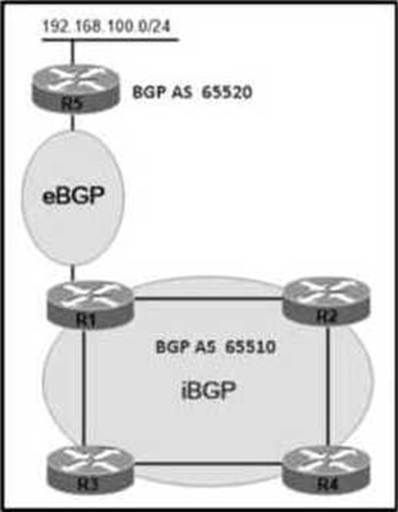
AS65510 iBGP is configured for directly connected neighbors. R4 cannot ping or traceroute network 192 168.100.0/24.
Which action resolves this issue?
- A . Configure R4 as a route reflector server and configure R1 as a route reflector client
- B . Configure R1 as a route reflector server and configure R2 and R3 as route reflector clients
- C . Configure R4 as a route reflector server and configure R2 and R3 as route reflector clients.
- D . Configure R1 as a route reflector server and configure R4 as a route reflector client
D
Explanation:
A route received from one iBGP peer will NOT be advertised to another iBGP peer. Therefore R4 could not receive advertisement for network 192.168.100.0/24. We can overcome this BGP limitation by configuring R1 as a route reflector server and R4 as a route reflector client so that R1 sends advertisements for R4.
Refer to the exhibit.
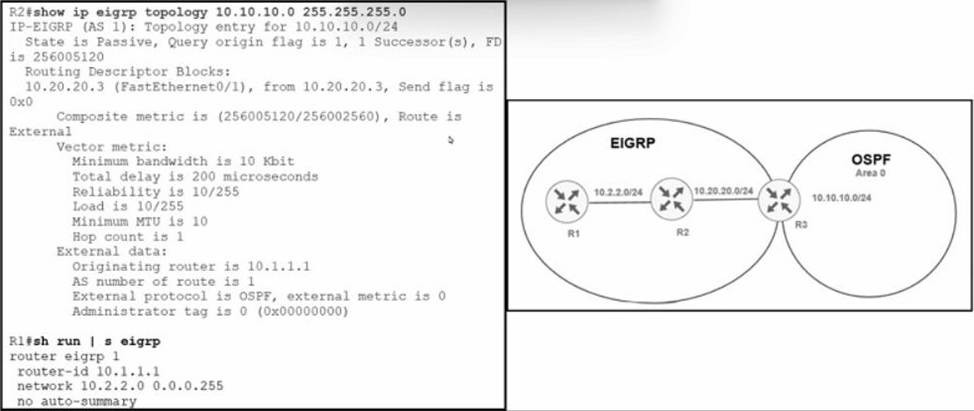
An engineer configured router R3 to redistribute the prefix 10.10.10.0/24 from OSPF into EIGRP R1 has no connectivity to the prefix.
Which action enables receipt of prefixes on R1?
- A . R3 is advertising the 10.20.20 0’24 prefix with a TTL of 1, R3 must set the TTL to 2 for this prefix.
- B . R1 docs not have a neighbor relationship with R2. The EIGRP process should be cleared on R1.
- C . Duplicate router IDs on R1 and R3, R1 should modify its router ID.
- D . R1 is not receiving the next-hop IP address of R3. R2 must enable the network 10 20.20.0V24 within EIGRP.
1.2/8 via 10.2.1.2, Tunnel1 created 00:00:12, expire 01:59:47
Type. dynamic, Flags: authoritative unique nat registered used
NBMA address: 10.12.1.2
What does the authoritative flag mean in regards to the NHRP information?
- A . It was obtained directly from the next-hop server.
- B . Data packets are process switches for this mapping entry.
- C . NHRP mapping is for networks that are local to this router.
- D . The mapping entry was created in response to an NHRP registration request.
- E . The NHRP mapping entry cannot be overwritten.
In which two ways does the IPv6 First-Hop Security Binding Table operate? (Choose two.)
- A . by IPv6 routing protocols to securely build neighborships without the need of authentication
- B . by the recovery mechanism to recover the binding table in the event of a device reboot
- C . by IPv6 HSRP to make sure neighbors are authenticated before being used as gateways
- D . by various IPv6 guard features to validate the data link layer address
- E . by storing hashed keys for IPsec tunnels for the built-in IPsec features
B,D
Explanation:
Overview of the IPv6 First-Hop Security Binding Table
A database table of IPv6 neighbors connected to the device is created from information sources such as NDP snooping. This database, or binding table, is used by variousIPv6 guard features to validate the link-layer address (LLA), the IPv4 or IPv6 address, and the prefix binding of the neighbors to prevent spoofing and redirect attacks.
IPv6 First-Hop Security Binding Table Recovery Mechanism The IPv6 first-hop security binding table recovery mechanism enables the binding table to recover in the event of a device reboot.
Reference: https://www.cisco.com/c/en/us/td/docs/ios-xml/ios/ipv6_fhsec/configuration/15-s/ip6-fhs-bind-table.html
Refer to the exhibit.

After redistribution is enabled between the routing protocols; PC2, PC3, and PC4 cannot reach PC1.
Which action can the engineer take to solve the issue so that all the PCs are reachable?
- A . Set the administrative distance 100 under the RIP process on R2.
- B . Filter the prefix 10.1.1.0/24 when redistributed from OSPF to EIGRP.
- C . Filter the prefix 10.1.1.0/24 when redistributed from RIP to EIGRP.
- D . Redistribute the directly connected interfaces on R2.
